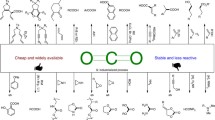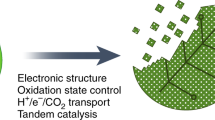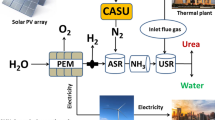Abstract
We present an overview of possible biotechnological applications for using carbon dioxide for the synthesis of chemicals. These approaches are very appealing as they contribute to the implementation of new synthetic methodologies that reduce waste and make a better use of carbon and energy. Several synthetic approaches will be considered including both the incorporation of the whole COO moiety or its reduction to other C1 molecules. Each option will be discussed making a comparison between the natural and artificial process in order to highlight the possibility to learn from Nature and develop useful mimetic or enzymatic systems.
Similar content being viewed by others
Explore related subjects
Discover the latest articles, news and stories from top researchers in related subjects.Avoid common mistakes on your manuscript.
Introduction
The control of the emission of CO2 is one of the major themes that influence the growth of economy and the development of our society. Several options are under assessment for making a list of priorities for the control of the immission of CO2 into the atmosphere. The capture of CO2 from flue gases from power plants or from industrial plants is a compulsory step. Captured CO2 can be either disposed or used.
The utilization of carbon dioxide, a source of carbon in synthetic chemistry, may contribute in two ways in avoiding CO2 emission, i.e., in terms of recycling carbon and reducing the CO2 emission because of the implementation of cleaner technologies.
Several industrial technologies on stream are not efficient either for the use of energy or for the aspect of atom economy. As a matter of fact, so far there has not been compulsory mandate to produce in a clean way, minimizing both the use of carbon and the production of waste.
Sustainable Chemistry poses constraints on the use of energy and requires the development of new synthetic methodologies characterised by a low environmental impact, while diversifying the raw material sources and reducing the use of fossil carbon. Carbon dioxide can be easily recovered from several industrial sources that produce pure streams, such as ammonia synthesis, fermentation, hydrogen production.
The high content of CO2 in such streams (also over 99%) and the absence of toxic species allows an immediate utilization of such carbon in a number of applications that may conveniently substitute currently used technologies that use complex routes for either the introduction of the carboxylic functionality into a molecule or the generation of large market chemicals. There are cases in which the application of carbon-dioxide-based technologies can really save energy and carbon.
Among many different possibilities, we shall consider the following examples
-
the synthesis of methanol (CH3OH);
-
the production of carboxylates (RCOOH); and
-
relevant compounds such as carbamic esters
and will compare the chemical routes with natural processes that use enzymes as catalysts.
The actual level of capability of using enzymes or mimetic systems in vitro will be analysed and the potential of developing new biotechnological applications for large-scale carbon dioxide conversion into useful chemicals will be assessed in terms of barriers to overcome for a practical utilization of the biotechnological approach. The genetic manipulation of RuBisCO (Ribulose Bisphosphate Carboxylase Oxidase) will also be discussed, and its contribution to solving the problem of carbon dioxide accumulation in the atmosphere commented.
Discussion
Synthesis of methanol
Today, methanol is synthesised (Eq. (1)) mainly from Syngas (H2–CO mixture), obtained in turn from coal or methane according to reactions (2)–(4), that are strongly endothermic:
The fact that reactions (2)–(4) are endothermic, obliges to burn fossil carbon for furnishing the necessary energy for Syngas synthesis. Consequently, despite the synthesis of methanol (Eq. (1)) is per se esothermic, also if the heat produced in this reaction is recovered, and the partial oxidation of methane (Eq. (5)), an esothermic process, is coupled to reactions (2)–(4) for producing Syngas, the overall energy balance is negative:
Considering the above reactions, one can observe that the synthesis of methanol shuttles carbon among different oxidation states. In fact, if coal is used, carbon is first oxidised from zero to two (in CO) and then reduced back to (−2) in methanol. Conversely, starting from methane, carbon is first oxidised from (−4) to (+2) and then reduced again to (−2). So far fossil carbon (coal, methane) has been used for Syngas production, while the utilization of CO2 according to reaction (3) is now under assessment. Also, CO2 can be converted into methanol by direct hydrogenation, using a mole of hydrogen in excess with respect to the use of CO (Eq. (6)):
Despite this, because of the low efficiency of the technology based on CO and the energetic cost of its production, the use of CO2 produces an energy saving, with better use of hydrogen and milder reaction conditions. As a matter of fact, CO2 is added to Syngas in the synthesis of methanol. As the latter may find use as fuel and raw chemical, such use of CO2 is quite important as might reduce the emission by 6–10 Mt/y.
Natural routes to methanol, follow two synthetic strategies: the reduction of carbon dioxide (Eq. (7)) or the direct oxidation of methane (Eq. (8)).

The process represented in Eq. (7) occurs in water at room temperature and requires different enzymes, each driving a specific reaction. The reduction of CO2 to formic acid, HCOOH, is driven by the Formate Dehydrogenase enzyme, a W, Mo enzyme. This reaction can be easily carried out in a chemical reactor by using metal catalysts that react CO2 and H2 and produce formic acid. The existing barrier to the exploitation of this process is the source of H2 that cannot be produced according to reactions (2)–(4). If H2 is produced from water electrolysis using nuclear power or photovoltaic energy, then the conversion of CO2 into HCOOH would represent a net CO2 reduction. The following step converts formic acid into formaldehyde under the formaldehyde dehydrogenase enzyme catalysis. Methanol is formed in the last step by the methanol-dehydrogenase enzyme. All these reactions can be carried out in vitro. The enzymes can be either used in cascade in solution in separate steps or encapsulated into a matrix that allows the simultaneous work of the three enzymatic systems. This biotechnology has a great interest because all reactions occur with high selectivity under mild conditions. Moreover, only the reactions catalysed by a given enzyme occur, so that it is possible to stop the conversion of CO2 at the wanted level by simply using the relevant enzymes. It is worth noting that among the reduction products of CO2, methanol is the most useful as it can be used as fuel (replacing gasoline) or as raw chemical for the production of gasoline and other chemicals such as acetic acid, dimethylcarbonate, to cite the most important. The fact that the reaction occurs in water is a great advantage, as it avoids the use of solvents and, thus, the production of organic waste that will generate CO2. The kinetics of the reaction can be ameliorated, but the limiting factor to a full exploitation of the biotechnological synthesis of methanol currently is the source of energy for CO2 reduction. In Nature, sunlight is the primary source and energy comes into the reaction through the NAD+/NADH couple. A practical application cannot be based on the use of NAD+/NADH as the cost would be prohibitive. Alternative sources must be found that can provide the necessary energy, are cheap and reversible. Either cheap, easily available chemicals can be used (sulphites, others) or a photoelectrochemical device can be developed that reduces back the oxidized term of the NAD+/NADH couple. The implementation of such process would be of great importance as would allow to recycle carbon in a cheap (economically and energetically) way, on a large scale (many tens Mt/y) due to the fact that methanol can find many uses in the energy and chemical industry.
The alternative way to methanol from methane is less suitable. In Nature Fe-enzymes (methane monooxygenase) are able to perform the “insertion” of one oxygen atom into the C–H bond of methane through the path reported in Eq. (9) (Lippard and Kopp 2002; Yoshizawa 2000).
The active site (Fig. 1) for dioxygen activation and methane hydroxylation is
Dinuclear iron active sites in M. capsulatus (Bath) MMOH (Rosenzweig et al. 1995)
located within a four-helix bundle in the α subunits of the α2β2γ2 hydroxylase (MMOH).
So far, such reaction has not been carried out in vitro and only chemical systems have been used for methane-controlled oxidation to methanol under drastic conditions (393 K in presence of concentrated sulphuric acid), not mimetic of natural processes, with low yield (Periana et al. 1998). This area is worth of further research because of the importance of the process.
Synthesis of carboxylates
The introduction of the carboxylic moiety (–COO) into an organic substrate is made today in a destructive way (Eq. (10)) or with the production of large amounts of waste and loss of metal atoms (Eq. (11)).

Conversely, in Nature the carboxylation occurs by using CO2 (Eq. (12)) or its hydrated form HCO3 − (Eq. (13)),

depending on if the active site of the enzyme is hydrophobic or hydrophilic, respectively. The key step in this reaction is the production of a nucleophilic carbon on the substrate that is made with a strong base. The use of the base cannot be stoichiometric, for economic and energetic reasons. This is the actual limit of mimetic processes that can promote the carboxylation of organic substrates containing active-H with the loss of 1 mol of H-acceptor (Chiusoli and Bottaccio 1966) or metal-atoms that stabilize the carboxylate moiety (–COO−) per mole of fixed CO2 (Eq. (14)):

where R1R2Im-2-CO2 is 1,3-dialkylimidazolium-2-car-boxylate, substrate is PhC(O)CH3, CH3OH, MX is NaBF4, NaBPh4, KPF6.
Should this limit be passed, the development of the direct carboxylation process would greatly contribute to developing clean methodologies in the direction of sustainable chemistry.
Another process that is worth of consideration is the carboxylation of phenol. Such reaction is the only carboxylation exploited industrially already since the late nineteenth century. The well-known Kolbe–Schmitt reaction (Eq. (15)) is performed for the synthesis of salicylic acid since 1869.

It gives a mixture of 2- and 4-OH-benzoic acid, depending on the metal used with the phenate (Na+ prefers the formation of 2-OH-benzoic acid, while K+ produces higher yields of the 4-isomer). The limitation of such reaction is the loss of one mol of metal cation per mol of acid produced and the selectivity that is less than 100% and requires complex purification techniques for getting pure products. It has been recently discovered (Aresta et al. 1998; Aresta and Dibenedetto 2002a) that in Nature the biodegradation of phenol by some anaerobic bacteria goes through the principle of “making more complex the structure of the product for an easier degradation.” In fact, phenol is first carboxylated to 4-OH-benzoic acid that is then dehydroxylated to benzoic acid which is then easily converted into CO2 and water (Scheme 1).
The isolation of the cytoplasmatic enzymatic pool has allowed to use in vitro the enzyme with a selective production of 4-OH-benzoic acid under mild conditions. The enzyme can be better used if supported on low melting agar-agar, or cut-off membranes can be advantageously used with the enzyme in solution (Aresta and Dibenedetto 2002a). The enzymatic carboxylation of phenol can be carried out also in sc-CO2, that represents the first example of utilization of such enzyme in absence of water. Obviously, the use of sc-CO2 is made possible by the fact that the carboxylation uses CO2 and not HCO3 − as substrate.
Synthesis of urea and carbamic esters
Carboxyphosphate (CP,2−O2(O)POC(O)O−) is used by living organisms for the elimination of ammonia and amines in the form of urea (Scheme 2A). It is produced in Nature from ATP, that is converted into ADP, and hydrogen carbonate (Eq. (16)).
CP cannot be synthesized in vitro from inorganic phosphate and hydrogen carbonate or CO2, also under high pressure. Conversely, the reaction of inorganic phosphonates with alkyl esters of carbonic acid affords a mixed anhydride (MA) that is structurally analogous to CP and performs the same reactions as CP in mild conditions (Scheme 2B) (Aresta et al. 2002b).
MA has been successfully used for synthetic purposes. It is able to convert very selectively aromatic amines into carbamates of industrial interest as they are precursors of isocyanates used for making polymers (Aresta et al. 1999). This technology avoids the use of phosgene for the synthesis of carbamates, isocyanates and polyurethans. In fact, when a primary amine is used it is very easy to convert the relevant carbamate into the relative isocyanate (Eq. (17)) used for the systems of polyurethans by reaction with alcohols.
Several diamines of industrial interest have been converted into their carbamates by using MA as catalysts under mild conditions (Aresta et al. 2002b).
Genetic manipulation of RuBisCO
RuBisCO (Ribulose 1,5-bis(phosphate)-carboxylase-oxidase) is by far the most abundant enzyme in Nature (Akazawa et al. 1987). It is present in good amounts in leaves of C3 plants (among which higher plants). It is strange that the most abundant enzyme is also the less specific: in fact both carboxylation of ribulose (at the C2 atom) and its oxidation (at the C2–C3 double bond of the enolic form) occur at the same site of the enzyme with the same rate. This makes 50% of the enzyme not usable for fixing CO2 according to Scheme 3, and 50% of ribulose is not converted directly into glucose.
As the C3 cycle runs several tens GtC per year in the natural carbon cycle, it is obvious of interest to improve the rate of carboxylation over that of oxidation. This can be done by facilitating the access of CO2 to the active site with respect to O2. An attempt has been made with an intervention on lysine that regulates the access of CO2. To date, results are not very encouraging, and it is still difficult to foresee if in the short term it will be possible to modify the enzyme and include it into higher plants. Should it be possible to increase the selectivity towards carboxylation by 10–20%, all problems relevant to the anthropogenic emission of CO2 could be solved, as Nature would be able to fix the excess CO2 produced in anthropic activities.
Conclusion
Biotechnologies could greatly help to solve either problems relevant to the development of new synthetic technologies with a step towards sustainable chemistry, or the important question of increasing the CO2 fixation through natural systems for a control of its accumulation into the atmosphere. Several options have been tested that gave interesting preliminary results and are worth of further development. The potential of biotechnologies in recycling carbon appears quite high in the long term, and limited to a few Mt/y in the medium term.
References
Aresta M, Quaranta E, Liberio R, Dileo C, Tommasi I (1998) Enzymic synthesis of 4-hydroxybenzoic acid from phenol and carbon dioxide: the first example of a biotechnological application of a carboxylase enzyme. Tetrahedron 54(30):8841–8846
Aresta M, Dibenedetto A, Quaranta E (1999) Selective carbomethoxylation of aromatic diamines. Green Chem 1(5):237–242
Aresta M, Dibenedetto A (2002a) Development of environmentally friendly syntheses: use of enzymes and biomimetic systems for the direct carboxylation of organic substrates. Rev Mol Biotech 90:113–128
Aresta M, Dibenedetto A (2002b) Mixed anhydrides: key intermediates in carbamates forming processes of industrial interest. Chem-A Eur J 8(3):685–690
Akazawa T, Incharoensakdi A, Takabe T (1987) Ribulose- 1,5-bisphosphate carboxylase/oxigenase (RuBisCO) (isolation, structure, and regulation). In: Aresta M, Forti G (eds) Carbon dioxide as a source of carbon: chemical and biochemical uses. Reidel Publ, Nato-Asi, pp 83–91
Chiusoli GP, Bottaccio G (1966) A new method for carboxylating active methylene groups with carbon dioxide. Chem Commun 618.
Lippard SJ, Kopp DA (2002) Soluble methane monooxygenase: activation of dioxygen and methane. Curr Opin Chem Biol 6:568–576
Periana RA, Taube DJ, Gamble S, Taube H, Satoh T, Fujii H (1998) Platinum catalysts for the high-yield oxidation of methane to a methanol derivative. Science 280:560–564
Rosenzweig AC, Nordlund P, Takahara PM, Frederick CA, Lippard SJ (1995) Geometry of the soluble methane monooxygenase catalytic diironcenter in two oxidation states. Chem Biol 2:409–418
Yoshizawa K (2000) Two-step concerted mechanism for methane hydroxylation on the diiron active site of soluble methane monooxygenase. J Inorg Biochem 78:23–34
Acknowledgement
Financial support by MIUR, PRIN 2003039774 is gratefully acknowledged.
Author information
Authors and Affiliations
Corresponding author
Rights and permissions
Open Access This is an open access article distributed under the terms of the Creative Commons Attribution Noncommercial License ( https://creativecommons.org/licenses/by-nc/2.0 ), which permits any noncommercial use, distribution, and reproduction in any medium, provided the original author(s) and source are credited.
About this article
Cite this article
Aresta, M., Dibenedetto, A. & Pastore, C. Biotechnology to develop innovative syntheses using CO2 . Environ Chem Lett 3, 113–117 (2005). https://doi.org/10.1007/s10311-005-0009-y
Received:
Accepted:
Published:
Issue Date:
DOI: https://doi.org/10.1007/s10311-005-0009-y








